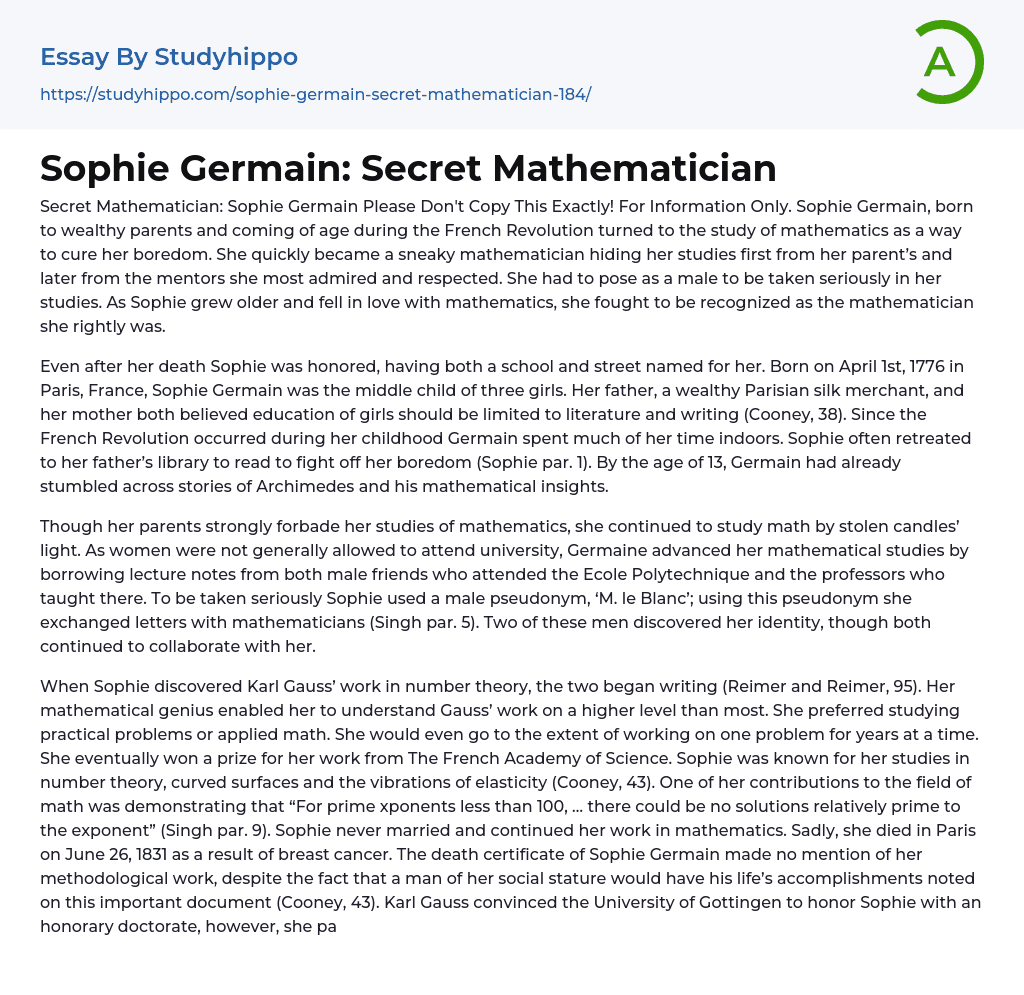Secret Mathematician: Sophie Germain Please Don't Copy This Exactly! For Information Only. Sophie Germain, born to wealthy parents and coming of age during the French Revolution turned to the study of mathematics as a way to cure her boredom. She quickly became a sneaky mathematician hiding her studies first from her parent’s and later from the mentors she most admired and respected. She had to pose as a male to be taken seriously in her studies. As Sophie grew older and fell in love with mathematics, she fought to be recognized as the mathematician she rightly was.
Even after her death Sophie was honored, having both a school and street named for her. Born on April 1st, 1776 in Paris, France, Sophie Germain was the middle child of three girls. Her father, a wealthy Parisian silk merchant, and her mother both believed education of girls s
...hould be limited to literature and writing (Cooney, 38). Since the French Revolution occurred during her childhood Germain spent much of her time indoors. Sophie often retreated to her father’s library to read to fight off her boredom (Sophie par. 1). By the age of 13, Germain had already stumbled across stories of Archimedes and his mathematical insights.
Though her parents strongly forbade her studies of mathematics, she continued to study math by stolen candles’ light. As women were not generally allowed to attend university, Germaine advanced her mathematical studies by borrowing lecture notes from both male friends who attended the Ecole Polytechnique and the professors who taught there. To be taken seriously Sophie used a male pseudonym, ‘M. le Blanc’; using this pseudonym she exchanged letters with mathematicians (Singh par. 5).
Two of these men discovered her identity, though both continued to collaborate with her.
When Sophie discovered Karl Gauss’ work in number theory, the two began writing (Reimer and Reimer, 95). Her mathematical genius enabled her to understand Gauss’ work on a higher level than most. She preferred studying practical problems or applied math. She would even go to the extent of working on one problem for years at a time. She eventually won a prize for her work from The French Academy of Science. Sophie was known for her studies in number theory, curved surfaces and the vibrations of elasticity (Cooney, 43). One of her contributions to the field of math was demonstrating that “For prime xponents less than 100, … there could be no solutions relatively prime to the exponent” (Singh par. 9). Sophie never married and continued her work in mathematics. Sadly, she died in Paris on June 26, 1831 as a result of breast cancer. The death certificate of Sophie Germain made no mention of her methodological work, despite the fact that a man of her social stature would have his life’s accomplishments noted on this important document (Cooney, 43). Karl Gauss convinced the University of Gottingen to honor Sophie with an honorary doctorate, however, she passed away prior to receiving the award (Cooney, 43).
One of the visible products of Germain’s work still stands today: The Eiffel Tower. Based on a paper she wrote and the continuing work of others made building the tower possible. Strangely enough, her name is absent from the 72 listed on the structure (Singh par. 16). Germain grew up sheltered by her wealthy parents during the French
Revolution. She found mathematics intensely interesting. She began her studies by candlelight, though her parents protested. Traditionally a male pursuit, Sophie hid her identity with a male pseudonym. Eventually discovered, her male mentors continued to work with her.
While not truly recognized in life, some of Sophie’s accomplishments have recognized since her passing. Works Cited Cooney, Miriam P. “Sophie Germain Ahead of Her Time in Applied Mathematics. ” Celebrating Women in Mathematics and Science. Reston: National Council of Teachers of Mathematics, Inc. 1996. Print. 37-44. Reimer, Luetta, and Wilbert Reimer. “Mathematics at Midnight. ” Mathematicians Are People, Too: Stories From The Lives of Great Mathematicians. Parsippany: Dale Seymour Publications. 1990. Print. 91-97. Singh, Simon. “Math’s Hidden Woman. ” Nov. 2000. Web. Oct. 2009. “Sophie Germain: Revolutionary Mathematician. “ Web. Oct. 2009.
- Academia essays
- Higher Education essays
- Language Learning essays
- Studying Business essays
- Education System essays
- Study essays
- First Day of School essays
- Scholarship essays
- Pedagogy essays
- Curriculum essays
- Coursework essays
- Studying Abroad essays
- Philosophy of Education essays
- Purpose of Education essays
- Brainstorming essays
- Educational Goals essays
- Importance Of College Education essays
- Brown V Board of Education essays
- The Importance Of Higher Education essays
- Online Education Vs Traditional Education essays
- Academic And Career Goals essays
- Academic Integrity essays
- Brown Vs Board Of Education essays
- Distance learning essays
- Technology in Education essays
- Vocabulary essays
- Writing Experience essays
- Importance of Education essays
- Early Childhood Education essays
- Academic Degree essays
- Academic Dishonesty essays
- School Uniform essays
- Academic writing essays
- Cheating essays
- Bachelor's Degree essays
- MBA essays
- College Life essays
- Grade essays
- Diploma essays
- Phonology essays
- Sentence essays
- Filipino Language essays
- Pragmatics essays
- Millennium Development Goals essays
- History Of Education essays
- Graduate School essays
- Middle School essays
- School essays
- Special Education essays
- University essays




